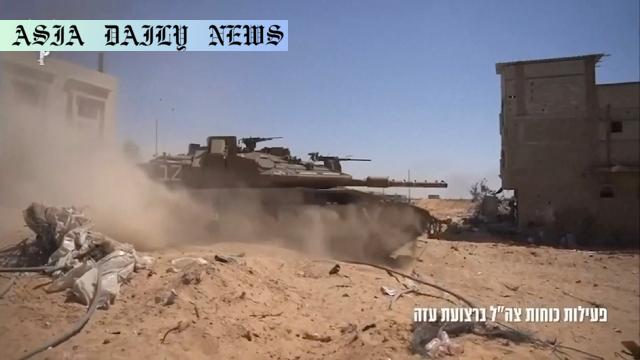Gaza Operations expand, as Israeli military launches intense ground and air assaults targeting over 670 Hamas strongholds.

Intensified Ground and Air Operations in Gaza
The Israeli military has initiated a significant escalation in its military operations within the Gaza Strip, marking one of the most extensive campaigns in recent years. Following announcements regarding their activities in the northern and southern regions, Israeli forces have focused ground and air efforts against identified Hamas targets. Over the course of their operations, the military has confirmed striking more than 670 sites, including weapons storage facilities, and employing troops in strategic deployments across Gaza.
This expansion of military activity was preceded by a sharp increase in airstrikes and tactical maneuvers, aimed at dismantling critical elements of Hamas infrastructure. Health officials have indicated a sharp rise in the number of casualties during the assaults, and concerns are mounting internationally regarding the toll the conflict is taking on civilians within the enclave.
Rising Humanitarian Concerns Amid Casualties
Reports emerging from the region paint a grim picture, with Qatar-based broadcaster Al Jazeera quoting health officials in Gaza who estimate at least 500 fatalities over the span of the last three days alone. The humanitarian crisis is worsening as medical facilities become overwhelmed by casualties, while thousands of civilians face displacement due to continuous bombardment. With escalating violence, aid organizations are warning that the civilian population remains most at risk, enduring extreme shortages in essential supplies including medical aid, food, and shelter.
Despite calls from various international organizations for a ceasefire and diplomatic resolution, the ongoing ground operations suggest that Israel is seeking to exert increased pressure on Hamas to achieve its strategic objectives. These objectives may include not only suppressing Hamas’ military capabilities but also negotiating terms favorable to Israel in any future peace talks.
Challenges in Doha Ceasefire Negotiations
Parallel to the ongoing military developments, discussions aimed at reaching a ceasefire are reportedly being held in Qatar. The Gulf nation, alongside other mediators, is attempting to broker an agreement between Hamas and Israeli authorities. Some reports indicate that a proposal under consideration involves Hamas releasing hostages in exchange for a temporary, two-month ceasefire agreement.
However, as tensions and conflicts intensify on the ground, hopes for a diplomatic resolution are beginning to wane. Observers speculate that Israel’s military engagements in Gaza are designed to weaken Hamas’ position before they are forced to negotiate. Unless significant progress is made swiftly, there’s concern that violence could escalate further, leading to yet more civilian casualties.
The Cost of Conflict and the Road Ahead
The international community continues to watch the unfolding events with alarm, urging both sides to consider the consequences of prolonged violence. The United Nations and other humanitarian organizations have called for an immediate halt to the fighting, emphasizing the dire need for humanitarian aid to safely reach the affected population.
For many families in the Gaza Strip, life has become a daily struggle for survival. This conflict reveals the complexity of geopolitical interests and the devastating consequences for ordinary civilians caught in the crossfire. The solution, while currently elusive, will require concerted international effort, negotiation, and compromise from all parties involved.
Commentary
Examining the Escalation in Gaza
The latest intensification of operations in Gaza serves as a stark reminder of the fragility of peace in one of the globe’s most volatile regions. The military campaign, which has seen over 670 Hamas targets struck and extensive ground incursions in both the northern and southern Gaza Strip, underscores the high stakes of this ongoing conflict. Yet, behind these numbers are countless civilian lives disrupted, highlighting the ever-present human cost of such geopolitical strife.
One cannot overlook the devastating humanitarian impact of military engagements in densely populated areas. The reported 500 casualties within just three days raise questions about proportionality, civilian protection, and the devastating ripple effects on Gaza’s infrastructure, from hospitals to essential services. These concerns should not only alarm international policymakers but prompt urgent action to ensure a sustained ceasefire and provide crucial humanitarian relief to affected populations.
Challenges in Ceasefire Mediation
The discussions taking place in Qatar highlight the challenges mediators face in reconciling divergent demands. While the focus on potential hostages offers some hope for negotiation, Israel’s strategic calculus seemingly revolves around increasing military pressure to extract significant concessions from Hamas. This approach, however effective militarily, risks exacerbating regional instability and complicating diplomatic efforts even further.
Efforts to reach a ceasefire must be redoubled, with a balanced approach aimed at addressing the root causes of the conflict. For long-term peace to take root, the voices of the innocent people affected by prolonged violence need to be brought to the forefront. Without sustained international pressure and engagement, the cost of delayed action will undoubtedly grow heavier with each passing day.
Healing the Fractured Fabric of Gaza
As the escalation continues, one is left contemplating what the future holds for Gaza and its people. The geopolitical dimensions of the conflict require not only immediate military or diplomatic solutions but concerted efforts toward rebuilding a fractured society. This includes addressing economic deprivation, fostering dialogue between conflicting sides, and creating pathways to lasting stability.
Ultimately, while the headlines often focus on the numbers and results of military operations, the world must not lose sight of the humanity at stake. The path forward demands empathy, diplomacy, and courage from global leaders, making it imperative to prioritize dialogue over militarization wherever possible. Only through such measures can there be any hope of a peaceful resolution that spares future generations the devastating consequences of conflict.


